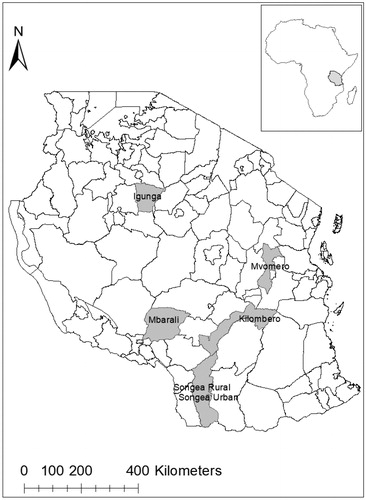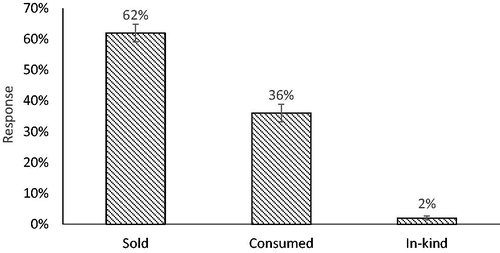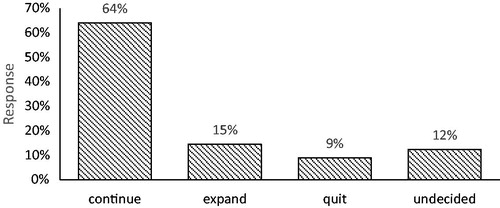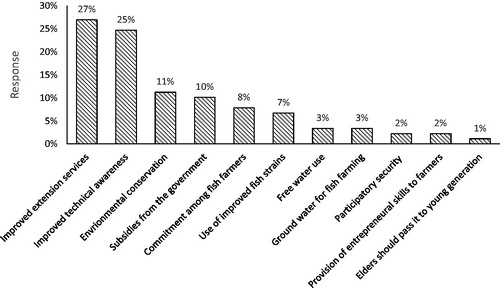Abstract
Rural fish farming is being promoted as a good source of protein and income diversification to fight poverty and inequality. However, its actual contribution to these rural households and local community at large is little known. Through interviews with 89 farmers’ and 6 key informants, we examined the contribution of rural fish farming to local farmers’ household income and investigate farmers’ perceptions, opportunities, and constraints towards fish farming in six districts of Tanzania. Results indicated that fish farming contributed on average 13% to household incomes and that it explained 5% of the variation of the household income while 84% of the variation was due to non-fish sources. The majority (79%) of the farmers wanted to continue with fish farming, 9% planned to quit, and 12% had not decided whether to continue or not. Conclusively, much higher aquaculture contribution towards rural development could be obtained if appropriate measures are taken.
Introduction
Aquaculture adoption can have various positive impacts at different levels from farm and household to community and national levels, by contributing to food and nutrition status to people (Filipski & Belton, Citation2018; Vilasante et al., Citation2015). It also helps to improve the purchasing power due to income generation from selling fish and create employment opportunities, which in turn significantly influence food demands and consumption (Belton & Little, Citation2011; Kassam & Dorward, Citation2017). The practice of aquaculture referred to as small scale rural aquaculture has gained a special attention in this regard, both in Sub-Saharan Africa (SSA) and internationally (Ahmed & Lorica, Citation2002; Bene et al., Citation2016; Brummet & Williams, Citation2000). In line with this, over 80% of the global aquaculture production is from small scale farms that are commonly owned and managed by families (De Silva & Davy, Citation2009; Gupta, Citation2018).
For many adopters of rural aquaculture, this technology is a supplementary activity mainly for providing extra income, food, and a strategy for diversification (Bous, Citation2000; Jahan & Pemsl, Citation2011; Toufique & Belton, Citation2014). This kind of aquaculture can easily be integrated with agricultural activities, like crop and animal husbandry with an aspect of improving output of the others. It was found for example in Malawi by Dey, Paraguas, Kambewa, and Pemsl (Citation2010) that integrating fish farming with agriculture lead to about six times increase in cash generated by the rural Malawian household. Similar results were reported by Berg, Söderholm, Söderström, and Tam (Citation2017) in Vietnam and Shoko et al. (Citation2019) in Tanzania.
Tanzania being encompassed with great lakes such as Victoria, Tanganyika, Nyasa, and the Indian Ocean, has for a long time relied on capture fisheries. However, with the widening gap between wild fish catch supplies and growing demand from a growing population, decrease of fish supply is experienced both in rural and urban households, hence threatening fish supply for both local consumption and trade (United Republic of Tanzania [URT], Citation2016a). According to the WordFish (2017) report, the per capita consumption of fish in Tanzania was 7.6 kg, which is only about one-third of the global per capita consumption of 20 kilograms per year. In response to this situation, fish farming is strongly suggested to bridge the gap and help to provide animal protein for a growing population.
Fish farming in Tanzania is dominated by fresh water rural pond fish farming with pond size of 150–300 m2 where O. niloticus is the dominant species followed by C. gariepinus (Kaliba, Osewe, Senkondo, Mnembuka, & Quagrainie, Citation2006). Other fish species with potential for aquaculture include milkfish (Chanos chanos) and the mud crab (Scylla cerata) that could be cultured in brackish and marine waters (Shoko et al., Citation2011b). According to the National bureau of statistics, Tanzania was estimated to have 13,011 fish ponds by 2005. Estimates for Citation2016 stands at 22,542 fish ponds engaging some 18,900 fish farmers with a total production of 3,840 metric tons per year valued at TZS 22,000 million in Citation2016 (National Bureau of Statistics [NBS], 2018).
However, despite its introduction over past the 50 years, aquaculture production in Tanzania has only increased slowly. Some reasons to this are a lack of enabling policies, techno-knowhow, credits, and high cost of imports and production (Kaliba et al., Citation2006). In response to this situation, a number of solutions such as development of suitable production systems, availability and accessibility of good quality seeds and feeds and more appropriate research and extension are proposed (Kaliba et al., Citation2006; Rutaisire, Charo-Karisa, Shoko, & Nyanda, Citation2009). Furthermore, the contribution of rural small scale fish farming to farmers’ livelihood and household income in particular is little known in Tanzania. Understating factors associated with income from fish farming and the degree to which it contributes to the farmers’ household income diversification, would be a good entry point toward more appropriate aquaculture promotion interventions, which in turn could help increase aquaculture adoption rates and production.
This study was conducted to assess the contribution of rural fish farming to the household income in some selected districts of Tanzania. This purpose is important considering the current debate about the contribution that rural aquaculture can make toward achieving the millennium development goals, and in particular poverty alleviation through income source diversification among rural households. For this study, we borrow a definition of rural aquaculture from Espinosa (Citation1999) who define it as “low-production medium-scale aquaculture, based on increasing natural water productivity, polycultures, and using alternative feed prepared with local or waste supplies”.
Specifically, we wanted to answer the following questions: (1) What is the income from fish farming and its contribution to the household income? (2) What are the factors influencing on the income from fish farming? (3) What are farmers’ perception and future plan regarding fish farming? (4) What are opportunities and constraints to further promote fish farming?
Methodology
Study area
A baseline survey was conducted between April and July 2017 to assess the contribution of fish farming to farmers’ household income. Surveyed districts () with the number of farmers in parenthesis included Kilombero (14), Mvomero (13), Igunga (11), Songea Urban (24), Songea Rural (13), and Mbarali (14) creating a total samples size of 89 farmers. The districts are characterized by unimodal rainfall pattern except Mvomero which experiences bimodal rainfall. The overall rainfall ranges from 450 mm in Igunga to 1,800 mm in Songea with the annual average temperature ranging from 11 °C in Songea to 35 °C in Mbarali (Balama, Augustino, Eriksen, Makonda, & Amanzi, Citation2013; Kayombo, Citation2016; NBS, Citation2018). The population mainly depends on agriculture. Rice irrigation farming is commonly practiced in Kilombero, Mbarali, and Igunga, while maize production is more common in urban and rural Songea. A mixture of maize, rice, and sorghum production is commonly found in Mvomero (NBS, Citation2018).
Pond fish farming is a more common practice in Songea rural, Songea urban, Mbarali, and Mvomero as it was introduced some time ago compared to Kilombero and Igunga where it was introduced recently (Chenyambuga, Mwandya, Lamtane, & Madalla, Citation2014; Limbu et al., Citation2017; Nilson & Wetengere, Citation1994). Additional fish farming background information of the surveyed districts is shown in . The choice of the surveyed districts was based on existence of a relative high number of fish ponds and also previous records of fish farming technology transfer efforts, such as trainings and fish seed dissemination.
Table 1. Some background information on fish pond farming in the surveyed districts (URT, Citation2016b).
Research design and data collection
Prior to the data collection, a pilot survey was conducted to pretest the questionnaire targeting 15 fish farmers who were not included in the actual survey. According to the Aquaculture Development Division report of Citation2016 (), the surveyed area had more than 3,153 fish farmers, and the sample size (89 farmers) in our study accounts only for 3% of all farmer in the surveyed area. Still we believe that the sample size is adequate to provide a deeper insight of the role of rural fish farming in contributing to household income among small scale fish farmers in Tanzania.
Depending on the fish farmer’s availability, our study employed three types of sampling techniques namely simple random, i.e. respondents having equal chance of being selected, purposively and snowball. Random sampling was used in districts like Songea rural and urban where a relatively high number of fish farmers compared to other districts were found, while purposive sampling was used where the number of fish farmers was few. Where no lists were available, snowball sampling was applied, whereby fish farmers were asked to identify their fellow fish farmers who were then selected for the survey.
The annual income was estimated from both on-farm and other income sources through personal interviews over a 12-month period from the last 1 or 2 years (2014/2015 or 2015/Citation2016) depending on the farmer’s memory. As far as farming products were concerned, both value of cash incomes obtained from marketed crops and those consumed by households as part of their subsistence was estimated and summed to obtain the total annual household income (Duc, Citation2009). This was made through in-depth discussion with the household heads. Monetary values of the products were obtained based on the prevailing market prices.1 This method was applied due to lack of public data and written records on fish pond economic performance in Tanzania.
Since the majority of fish farmers had one or more economic activities apart from fish farming, it was felt worth investigating the influence of household livelihood diversification on the income obtained from fish farming. We hypothesized that due to time and Labor constraints, fish farmers with higher numbers of economic activities (more diversified farmers) will have less fish income compared to those with less economic activities (less diversified farmers). We categorized fish farmers into three groups based on degree of diversification: fish farming with one extra activity, f + 1; fish farming with two extra activities, f + 2; and fish farming with three or more activities, f + 3 then comparing their fish income, non-fish income, and total household income.
Supplementary information was collected through key informant interviews and field observation for the purposes of cross-checking some of the information obtained through questionnaires, especially on fish pond characteristics and management strategies. Socio-economic characteristic information about the fish farmers, such as age, gender, household size, education level, experience in fish farming, future plans, constraints, and perception on fish farming were also collected. This information was used to assess their influence on fish income generation. In addition to assessing the contribution of fish farming to the household economy, we also wanted to get insights on the impact from fish farming on the household food security. This was done by asking farmers to estimate the portion of farmed fish that is used directly for home consumption as opposed to the share sold for cash. The interview lasted for about 1 h.
Statistical analysis
ANOVA was used to analyze the impact of livelihood diversification on fish and household income. Multiple regression was conducted to assess how fish and non-fish income explain household income. The influence of farmer’s socio-economic characteristics on fish income and also the relationship between household income and farmed fish utilization pattern was done using correlation analysis. Data were transformed to log base ten in case of non-conformity to parametric assumption and, when data did not fit for parametric test even after the transformation, alternative non-parametric tests were used. Analysis was done using Microsoft Excel and SPSS statistical software (Version 20). Seventeen individuals were not included in the economic analysis due to lack of information.
Results and discussion
Socioeconomic profile of the fish farmers
Socioeconomic characteristics of the respondent fish farmers are presented in . Male constituted 93% of all farmers with only 7% being female. The majority (66%) of the farmers had a household size of six or less members. About 57% of the farmers had a standard seven level of education with an average of 9.4 years of schooling. About 45% had less than 5 years of fish farming experience. Pond sizes ranged from 24 to 2,875 m2 with an average size of 399 m2. All fish farmers had multiple sources of income where, 95.8% were involved in crop farming; 34.5% in animal husbandry; 6.9% in public services; 42% in small trade; and 12% were involved in other income-generating activities. A majority (50%) had at least two additional sources of income apart from fish farming, with a combination of crop farming, small business, and husbandly being the most common.
Table 2. Gender, age, pond size, household size, education level, and experience among interviewed fish farmers in selected districts in Tanzania.
Impact of fish farming on household income
The annual household income was in on average 1,681 US$ and the major income source was crop farming (). About 31% of the respondents had an average annual income below 694 US$, which according to the World bank classify these farmers as living in extreme poverty with an income below the international poverty line of 1.90 US$ per day (Word Bank, Citation2019). The average annual income from fish farming among the respondents was 222 US$ (). The fish farming’s share to the household total income was on average 13% (). These results are in range with those reported by previous authors. Dey et al. (Citation2006), assessing the impact of integrated fish farming in Malawi, reported a 12% contribution of fish farming to household income. Similarly, Kassam and Dorward (Citation2017) comparing the poverty impact of fish farming in Ghana, indicated a share of 8% from fish farming to the household income. However, this contribution is still low compared to many countries in southeast Asia. Rahman, Haque, and Rahman (Citation2011), for instance, reported that up to 86% of some Bangladesh household incomes came from small scale fish farming. A Pearson correlation analysis indicated a significant negative correlation (r = −0.43, p < 0.01) between the contribution of fish income to household income and total household income, suggesting that fish farming has a more significant contribution to poor household income when compared with the well-off farmers. Similar results were reported by Brummet (Citation1999) and Dey et al. (Citation2010) in Malawi.
Table 3. Annual average household income (US$/year) from fish farming and other sources and their contribution to the household income.
Multiple regression analysis results indicated that both fish and non-fish income can jointly explain 96.4% variation on annual household income of the respondent fish farmers (R = 0.982, F (2,69) = 943.9, p < 0.01). It was found that fish farming has a significant influence on the household income (β = 0.176, p < 0.01), as did non-fish income (β = 0.792, p < 0.01) (). These results suggest that a percentage increase in fish income and non-fish income lead to increased household income by 0.18 and 0.79%, respectively. Although the relatively low influence of fish farming to household income when compared with other sources, the contribution was still statistically significant and suggests that there is a potential for households to get more income from fish if enough emphasis is put on this sector as it is usually done on other production activities. Lower production from fish farming compared to that from agriculture and other activities could thus be related to lower input, poor management practices and the fact that it is not usually a first priority income source (Brummett, Citation2000; Kassam & Dorward, Citation2017).
Table 4. Summary of regression model of the total household income as determined by fish and non-fish incomes.
Household livelihood diversification and income from fish farming
There were no statistical difference (F (2,69) = 1.085, p = 0.344) in fish farming income between less diversified farmers and those who were more diversified (). However, there was an increasing trend in fish income from f + 1 to f + 2 and then a sharp drop from f + 2 to f + 3 suggesting a decrease in fish income when a farmer engages in more than two additional economic activities. As a majority of the fish farmers participated in agriculture production and small businesses, higher fish income from f + 2 farmers could be a result of both integrating fish and agriculture (IAA) leading to higher pond output (Limbu et al., Citation2017) and also entrepreneurial skills obtained from small businesses, which in turn lead to higher fish income (Heenkenda & Chandrakumara, Citation2016; Pemsl, Dey, & Bose, Citation2006). It was for example reported by Dey et al. (Citation2010) in Malawi that, IAA farmers obtained 11% and 134% higher farm productivity and farm income per hectare, respectively, than non-IAA farmers. Lower fish income from f + 3 compared to f + 2 could be related to limited allocation of inputs like time and labor. On the other hand, degree of diversification tended to increase with both non-fish and total income. This is in agreement with Bosma, Udo, Vareth, Visser, and Nam (Citation2005) who reported a positive relationship between the degree of diversification and household income. The inverse relationship between percentage contribution from fish farming to household income and number of livelihood options is related to the fact that the contribution from individual income sources tends to decrease as the contribution is shared between other sources.
Table 5. Average income (US$ per year) of household grouped by income sources and degree of livelihood diversification.
Utilization pattern of the cultured fish
About 62% of the farmed fish was sold, 36% was used for household consumption and 2% was given away (). There was a significant positive correlation between total household income and the portion sold (rho = 0.595, p < 0.01). On the other hand, total household income had a significantly negative correlation with the proportion consumed (rho = −0.581, p < 0.01) and the proportion given away (rho = −0.272, p = 0.021). It seems as poor fish farmers (based on household income) consumed a larger proportion of their pond harvest compared to better-off farmers. This indicates that fish farming contributes more to food security among low income households as compared to high income households. The overall large portion (62%) of the total harvest being sold could be associated partly with the need for cash for other costs or lack of cold storage facilities, especially in rural areas. Similarly, Nzevu, Amwata, and Mutua (Citation2018), assessing the contribution of fish farming to households in Kenya, reported a relatively large portion of farmed fish being sold compared to that consumed. Furthermore, Kassam and Dorward (Citation2017) found that more than 60% of the fish harvested from aquaculture by both poor and well-off farmers in Ghana were sold in the local market. The small portion which was usually given away as a gift to neighbors, relatives, and friends was perceived as a way to maintain good societal relationships and well-being within the community.
Factors associated with income from fish farming
Overall (), there was a positive correlation between pond fish farming income and: household income per person (rho = 0.585, p = 0.065); farming experience (rho = 0.235, p = 0.047) and training in fish farming (rho = 0.422, p < 0.01). Thus the results suggest that a higher income per person generates a higher purchasing power for inputs and that higher experience and training improves the fish farming skills. Investigating the impact of extension services among Egyptian fish farmers, Dickson, Nasr-Allah, Kenawy, and Kruijssen (Citation2016) reported a higher profit from trained farmers compared to the control. Similar results were reported by Dey et al. (Citation2010) in Malawi, and Kassam and Dorward (Citation2017) in Ghana. Despite the fact that 93% of the respondent household heads were male, which is a typical Tanzanian household characteristic, the role of gender should also be acknowledged as women played a significant contribution in all aspects and stages of household pond fish farming () indicating a need for gender consideration in relation to rural fish farming and development. Other studies that assessed the role of female in fish farming in Tanzania and other developing countries reported similar findings. In Ukerewe island of Lake Victoria, Luomba (Citation2013), for example, indicated that women were involved in many different activities related to pond farming including pond construction, fingerlings sorting, pond stocking, feeding, sex identification, and fish harvesting. Example of similar findings from outside Tanzania includes those by Ahmed, Halim, and Shamima (Citation2012) in Bangladesh and Farquhar, Khanal, Shrestha, Farthin, and Bhujel (Citation2019) in Nepal.
Figure 3. Gender and age groups participating in household fish farming management practices. Source: Field survey, April–July 2017.
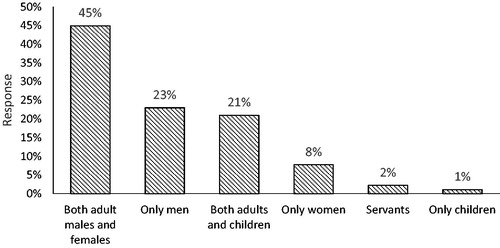
Table 6. Spearman correlation results for factors associated with income from fish farming.
Opportunities, constraints, and perception to further fish farming expansion
About 52% of the respondent fish farmers were trained in general fish farming and 2% on fish pond construction, while 46% had not received any training at all. The 2% trained in fish pond construction played a significant role in transferring fish farming technology to other farmers, as they acted as local engineers in pond construction in the community. The majority (64%) expressed a willingness to continue with fish farming at least at the current scale, 15% wanted to expand their activities, 9% wanted to quit while 12% had not decided whether to continue or not (). Regarding motivation factors for continuing with fish farming, 48% of the farmers saw fish farming as an important source of protein while 31% found fish farming as a way to diversify their income. Other factors that created a positive attitude toward fish farming included social identity (13%), pond water for vegetable irrigation (3%), and less labor demanding as compared to agriculture (3%). The reasons for the small portion of fish farmers who wanted to abandon fish farming included limited time, problems with the water, security, and profit.
Using closed questions in a Likert scale respondents ranked stunted growth of fish (64%) to be the most serious problem followed in sequence by water-related constraints (45%), lack of good quality fingerlings (38%), high pond construction costs (38%), and high fish seed prices (31%) (). Apart from fish seed and water-related problems, small-sized harvested fish was associated with factors like: (1) Lack of good quality feeds which led to fish malnutrition; (2) ponds being distantly located from residential areas making it easy for poachers to take big fish and leave small ones; and (3) pests like otters, monitor lizards, and frogs which negatively affected the pond fish yield.
Table 7. Farmers’ perception on fish farming challenges and their severity.
Farmers were also asked to rate the status of fish farming adoption in the community. The adoption rate was assessed by comparing the number of fish farmers in relation to the community population size. About 64% of the respondents considered that the community fish farming uptake was poor, 18% very poor, 10% normal, and 4% that it was in an emerging stage ().
Figure 5. Farmers’ perception on the adoption rate of fish farming in the community. Source: Field survey, April–July 2017.
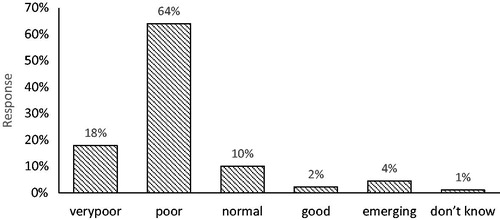
Lack of appropriate fish farming skills was the most common factor mentioned for poor community fish farming adoption rate (), which was also evident during our field observation. For instance, a large number of farmers did not know exactly their fish pond size. Since most of pond inputs such as number of fish to be stocked, fertilization regime, and feed quantity are determined by the pond size among other factors, this could have a negative implication on the resource use efficiency and pond productivity in general, thus leading to disappointment in the fish farming. Similar to our study, Sheheli, Fatema, and Haque (Citation2014), assessing the existing status and management practice in Bangladesh observed a lack of knowledge being a major factor hindering fish pond productivity. This situation calls for immediate need to improve farmer knowledge through extension services, training, and on-farm trials as a way to increase aquaculture adoption rate in Tanzania.
Figure 6. Reasons for poor community fish farming adoption status based on farmers’ perception. Source: Field survey, April–July 2017.
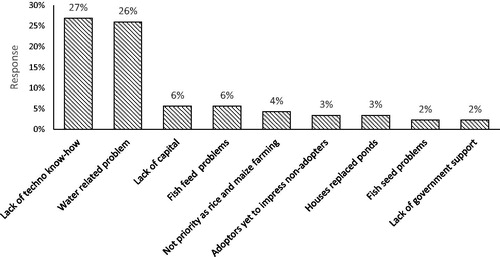
Second to lack of enough fish farming knowledge was water-related problems. This was mainly perceived to be a result of anthropogenic activities, climate changes, and policy issues. Farmers thought that construction of fish ponds and houses nearby water sources upstream caused water scarcity to fish ponds located downstream resulting in abandonment of a number of fish pond downstream. Also, climate change-related problems such as uncertain rainfall and increasing temperatures were thought to cause problems with shortage of water.
For the policy issues, a recently introduced regulation that ban any establishment of human activities 60 m from riverbanks and lakeshores (United Republic of Tanzania [URT], Citation2004), had decreased the in number of fish ponds in some areas. Furthermore, the introduction of water use permits which require famers to pay for water use had also negatively affected the number of fish farmers in the community. For example, farmers in Mvomero argued that they cannot afford to pay for water, a resource they have been using without any cost for a long time. It was noted that there is some misunderstanding between fish farmers and policy makers regarding the introduced regulations. Some farmers felt that fish farming was marginalized when it comes to water uses as compared to other agricultural practices. This calls for a need for authorities to help farmers to better understand the meaning and purpose of the newly established regulations.
Low support from the government and lack of commitment from fish farmers discouraged non-fish farmers to start with fish farming. For example, some fish farmers saw fish farming as a low priority side-activity which was only attended when other activities especially agriculture was completed. A similar trend was reported by Brummet (Citation2005) who assessed why Malawian farmers did not feed their fish. Since agriculture has already gained popularity in Tanzania, it would therefore make sense if integrated agriculture and aquaculture farming would be stronger promoted for improved productivity of both crops and fish (Kinkela et al., Citation2017; Limbu et al., Citation2017; Shoko et al., Citation2019). In regard to government support, farmers suggested that subsidies for high quality fish seed, feeds, and pond construction should be provided.
Further to the above perceived reasons for poor adoption rate of fish farming was the issue of land-use changes resulting from population growth, leading to competition of space between different human activities. It was reported in Songea urban that a large number of fish ponds were already replaced by houses because land buyers offered attractive money packages which convinced local fish farmers to sell their fish farming areas. The situation calls for a better urban planning strategies regarding land uses to avoid potential conflicting land uses.
In response to the above challenges, a number of solution were suggested by farmers (). In order to increase the technical efficiency in fish farming, extension services should be improved through frequent farm visits, short trainings, and on-farm demonstrations. Fish farming to a large extent depends on water availability. As water scarcity was perceived as one of the biggest problems, farmers suggested initiatives to protect catchment areas in order to improve water availability. Furthermore, the use of ground water for fish farming was seen as a way to overcome water-related problems. However, since well drilling is known to be too expensive for local farmers, it was advised that this could be done through government and non-governmental intervention using subsidies to construct boreholes for farmers.
Conclusion
The main objective of our study was to assess the role of rural fish farming and factors influencing its contribution to household income in Tanzania. The study indicates that 13% of the fish farmers’ household income come from fish farming. In absolute terms, fish income increased with increase in household income while its relative contribution to household income increased with decreased household income. These findings contribute to the ongoing debate over the role of rural fish farming to household poverty reduction and development. However, at the current level of production this contribution is still low when compared with other countries outside SSA. Considering the good climatic condition and the willingness of people to farm fish, there is a potential for much higher output from fish farming. It seems, in particular that fish farming can be a good source of income and food security, and rural fish farming should certainly receive more attention from local people as well as from local and national policy to further encourage aquaculture expansion in Tanzania. We recommend future studies assessing the role of rural fish farming on household food security, health, and rural economies. These would further highlight the contribution of technology toward improving the quality of life in Tanzania.
Acknowledgements
We are grateful to fish farmers for taking their time to respond to the questionnaires and district fisheries officers who helped in data collection.
Disclosure statement
No potential conflict of interest was reported by the author(s).
Note
Additional information
Funding
Notes
1 The price of produce varied across the districts and time with statistically insignificant differences. Moreover, as the study explored the overall income contribution from aquaculture, price variation was not considered.
References
- Ahmed, K., Halim, S., & Shamima, S. (2012). Participation of women in aquaculture in three coastal districts of Bangladesh: Approaches toward sustainable livelihood. World Journal of Agricultural Sciences, 8 (3), 253–268.
- Ahmed, M., & Lorica, M. H. (2002). Improving developing country food security through aquaculture development—Lessons from Asia. Food Policy, 27(2), 125–141. doi:10.1016/S0306-9192(02)00007-6
- Balama, C., Augustino, S., Eriksen, S., Makonda, F., & Amanzi, N. (2013). Climate change adaptation strategies by local farmers in Kilombero district, Tanzania. Ethiopian Journal of Environmental Studies and Management, 6, 724–736. doi:10.4314/ejesm.v6i6.3S
- Belton, B., & Little, D. C. (2011). Immanent and interventionist inland Asian aquaculture development and its outcomes. Development Policy Review, 29 (4), 459–484. doi:10.1111/j.1467-7679.2011.00542.x
- Bene, C., Arthur, R., Norbury, H., Allison, E. H., Beveridge, M., Bush, S., … Williams, M. (2016). Contribution of fisheries and aquaculture to food security and poverty reduction: Assessing the current evidence. World Development, 79, 177–196. doi:10.1016/j.worlddev.2015.11.007
- Berg, H., Söderholm, A. E., Söderström, A. S., & Tam, N. T. (2017). Recognizing wetland ecosystem services for sustainable rice farming in the Mekong Delta, Vietnam. Sustainability Science, 12(1), 137–154. doi:10.1007/s11625-016-0409-x
- Bosma, R. H., Udo, H. M. J., Vareth, J. A. J., Visser, L. E., & Nam, C. Q. (2005). Agriculture diversification in the Mekong Delta: Farmers’ motives and contributions to livelihoods. Asian Journal of Agriculture and Development, 2(1&2), 49–66.
- Bous, H. E. (2000). Commercial vegetable and polyculture fish production in Bangladesh: Their impacts on household income and dietary quality. Food and Nutrition Bulletin, 21(4), 482–487.
- Brummet, R. E. (1999). Integrated aquaculture in Sub-Saharan Africa. Environment, Development and Sustainability, 1, 315–321.
- Brummet, R. E. (2005). Why Malawian smallholders don’t feed their fish. University of Malawi, Bunda College of Agriculture. Aquaculture and Fisheries Document, No. 53.
- Brummett, R. E. (2000). Factors influencing fish prices in Southern Malawi. Aquaculture, 186(3-4), 243–251. doi:10.1016/S0044-8486(99)00383-X
- Brummet, R. E., & Williams, M. J. (2000). The evolution of aquaculture in African rural & economic development. Ecological Economics, 33, 193–203. doi:10.1016/S0921-8009(99)00142-1
- Chenyambuga, S. W., Mwandya, A., Lamtane, H. A., & Madalla, N. A. (2014). Productivity and marketing of Nile tilapia (Oreochromis niloticus) cultured in ponds of small-scale farmers in Mvomero and Mbarali districts. Tanzania. Livestock Research for Development, 26 (3), 1–13.
- De Silva, S. S., & Davy, F. B. (2009). Aquaculture successes in Asia, contributing to sustained development and poverty alleviation. In S. S. De Silva & F. B. Davy (Eds.), Success stories in Asian aquaculture (pp. 1–14). Doordrecht, Germany: Springer-NACA-IDRC.
- Dey, M. M., Kambewa, P., Prein, M., Jamu, D., Paraguas, F., Pemsl, D., & Briones, R. (2006). Impact of the development and dissemination of integrated aquaculture-agriculture (IAA) technologies in Malawi. NAGA WorldFish Centre Quarterly, 29 (1&2), 28–35.
- Dey, M. M., Paraguas, F. J., Kambewa, P., & Pemsl, D. E. (2010). The impact of integrated aquaculture–agriculture on small-scale farms in Southern Malawi. Agricultural Economics, 4, 67–79. doi:10.1111/j.1574-0862.2009.00426.x
- Dickson, M. D. A., Nasr-Allah, A., Kenawy, D., & Kruijssen, F. (2016). Increasing fish farm profitability through aquaculture best management practice training in Egypt. Aquaculture, 465, 172–178. doi:10.1016/j.aquaculture.2016.09.015
- Duc, N. M. (2009). Economic contribution of fish culture to farm income in Southeast Vietnam. Aquaculture International, 17(1), 15–29. doi:10.1007/s10499-008-9176-8
- Espinosa, M. (1999). La acuicultura rural en pequeña escala en el mundo. [Small-scale rural aquaculture in the world]. Rome: FAO.
- Farquhar, S. D., Khanal, N., Shrestha, M., Farthin, M., & Bhujel, R. C. (2019). Socio-economic impacts of the Women in Aquaculture (WiA) project in Nepal. Kasetsart Journal of Social Sciences, 40, 289–295. doi:10.1016/j.kjss.2017.12.014
- Filipski, M., & Belton, B. (2018). Give a man a fishpond: Modeling the impacts of aquaculture in the rural economy. World Development, 110, 205–223. doi:10.1016/j.worlddev.2018.05.023
- Gupta, M. V. (2018). Contribution of aquaculture to global food security. Hyderabad, India: WorldFish Center (CGIAR).
- Heenkenda, S., & Chandrakumara, D. P. S. (2016). Entrepreneurial skills and farming performance: Implications for improving banana farming in Sri Lanka. International Journal of Humanities and Social Sciences, 7(1), 14–26.
- Jahan, K. M., & Pemsl, D. E. (2011). The impact of integrated aquaculture-agriculture on small-scale farm sustainability and farmers’ livelihoods: Experience from Bangladesh. Agricultural Systems, 104, 392–402. doi:10.1016/j.agsy.2011.01.003
- Kaliba, A. R., Osewe, K. O., Senkondo, E. M., Mnembuka, B. V., & Quagrainie, K. K. (2006). Economic analysis of Nile tilapia (Oreochromis niloticus) production in Tanzania. Journal of the World Aquaculture Society, 37(4), 464–473. doi:10.1111/j.1749-7345.2006.00059.x
- Kassam, L., & Dorward, A. (2017). A comparative assessment of the poverty impacts of pond and cage aquaculture in Ghana. Aquaculture, 470, 110–122. doi:10.1016/j.aquaculture.2016.12.017
- Kayombo, W.C. (2016). Assessing meteorological data for reference evapotranspiration in Kyela and Mbarali district. Journal of Environment and Earth Science, 6(4), 2224–3216.
- Kinkela, P. M., Mutiaka, B. K., Dogot, T., Dochain, D., Rollin, X., Mvubu, R. N., … Bindelle, J. (2017). Diversity of farming systems integrating fish pond aquaculture in the province of Kinshasa in the Democratic Republic of the Congo. Journal of Agriculture and Rural Development in the Tropics and Subtropics, 18(1), 149–160.
- Limbu, S. M., Shoko, A. P., Lamtane, H. A., Kishe-Machumu, M. A., Joram, M. C., Mbonde, A. S., … Mgaya, Y. D. (2017). Fish polyculture systems integrated with vegetable improves yield and economic benefits on small scale farmers. Aquaculture Research, 48(7), 3631–3641. doi:10.1111/are.13188
- Luomba, J. O. (2013). Role and place of women in aquaculture a case study of Ukerewe district, Tanzania. International Journal of Aquaculture, 18(3), 101–104. doi:10.5376/ija.2013.03.0018
- National Bureau of Statistics (NBS). (2018). National Environmental Statistics Report (NESR, 2017). Tanzania, Mainland.
- Nilson, H., & Wetengere, K. (1994). Adoption and viability criteria for semi-intensive fish farming: A report on a socio-economic study in Ruvuma and Mbeya regions, Tanzania. Aquaculture for Local Community Development Program (ALCOM) Report 28. Rome, Italy: Food and Agriculture Organization of the United Nations.
- Nzevu, J. M., Amwata, D. A., & Mutua, A. K. (2018). The contribution of fish farming to household wellbeing of fish farmers in Kitui central sub-county, Kitui county. Journal of Agriculture and Veterinary Science, 11, 69–76.
- Pemsl, D. E., Dey, M. M., & Bose, M. L. B. (2006). Determining high potential aquaculture production areas: Analysis of key socioeconomic adoption factors. In Proceedings of the Thirteen Biennial Conference of the IIFET, July 11-14, 2006, Portsmouth, UK: Rebuilding Fisheries in an Uncertain Environment. Compiled by Ann L Shriver. IIFET, Corvallis, Oragon, USA. CD ROM ISBN. 0-976332432-3-2
- Rahman, S. M.A., Haque, A., & Rahman, S. M. A. (2011). Impact of fish farming on household income: A case study from Mymensingh District. Journal of Social Sciences, 7 (2), 127–131. doi:10.3844/jssp.2011.127.131
- Rutaisire, J., Charo-Karisa, H., Shoko, A.P., & Nyanda, B. (2009). Aquaculture for increased fish production in East Africa, a review. African Journal of Tropical Hydrobiology and Fisheries, 12, 74–77. doi:10.4314/ajthf.v12i1.57379
- Sheheli, S., Fatema, K., & Haque, S. M. (2014). Existing status and practices of fish farming in Trishal Upazila of Mymensigh district. Progressive Agriculture, 24(1-2), 191–201. doi:10.3329/pa.v24i1-2.19172
- Shoko, A. P., Lamtane, H. A., Wetengere, K., Kajitanus, O., Msuya, F. E., Mmochi, A. J., & Mgaya, Y. D. (2011b). The status and development of aquaculture in Tanzania, East Africa. In P. Natarajan, L. Wondimu, T. Boyossa, M. I. Zuberi, A. S. Nair, A. Beyeh, & E. Aga (Eds.), Technical Proceedings of the International Conference on Ecosystem Conservation and Sustainable Development (ECOCASD 2011) (pp. 85–97). Ambo, Ethiopia: Ambo University.
- Shoko, A. P., Limbu, S. M., Lamtane, H. A., Kishe-Machumu, M. A., Sekadende, B., Ulotu, E. E., … Mgaya, Y. D. (2019). The role of fish-poultry integration on fish growth performance, yields and economic benefits among smallholder farmers in sub-Saharan Africa, Tanzania. African Journal of Aquatic Science, 44(1), 15–24. doi:10.2989/16085914.2018.1555512
- Toufique, K. L., & Belton, B. (2014). Is Aquaculture pro-poor? Empirical evidence of impacts on fish consumption in Bangladesh. World Development, 64, 609–620. doi:10.1016/j.worlddev.2014.06.035
- United Republic of Tanzania (URT). (2004). United Republic of Tanzania: The National Environmental Management Act of 2004.
- United Republic of Tanzania (URT). (2016a). National fisheries Sector: Challenges and opportunities report. Ministry of agriculture, livestock and fisheries.
- United Republic of Tanzania (URT). (2016b). Ministry of livestock and fisheries development, fisheries sector. Aquaculture Development Division. Aquaculture production statistics 2015/2016.
- Vilasante, S., Rodriguez, S. R., Molares, Y., Martinez, M., Remiro, J., Garcia-Diez, C., … Awity, L. (2015). Are provisioning ecosystem services from rural aquaculture contributing to reduce hunger in Africa?. Ecosystem Services, 16, 365–377. doi:10.1016/j.ecoser.2015.07.003
- Word Bank. (2019). Decline of global extreme poverty continues but has slowed. Retrieved from https://www.worldbank.org/en/news/press-release/2018/09/19/decline-of-global-extreme-poverty-continues-but-has-slowed-world-bank.
- WorldFish. (2017). Factsheet: 2017-18. Penang, Malaysia: WorldFish in Tanzania.

